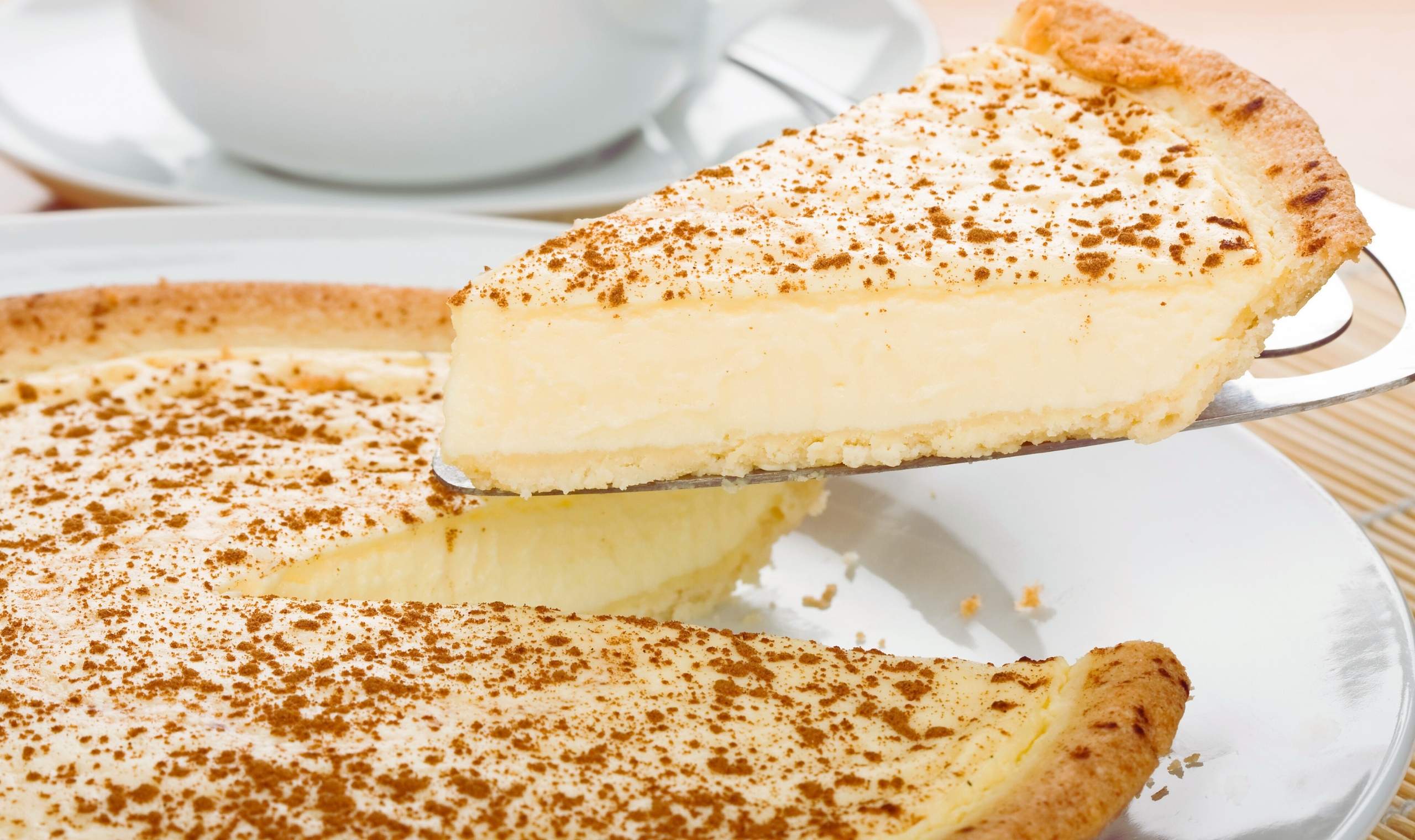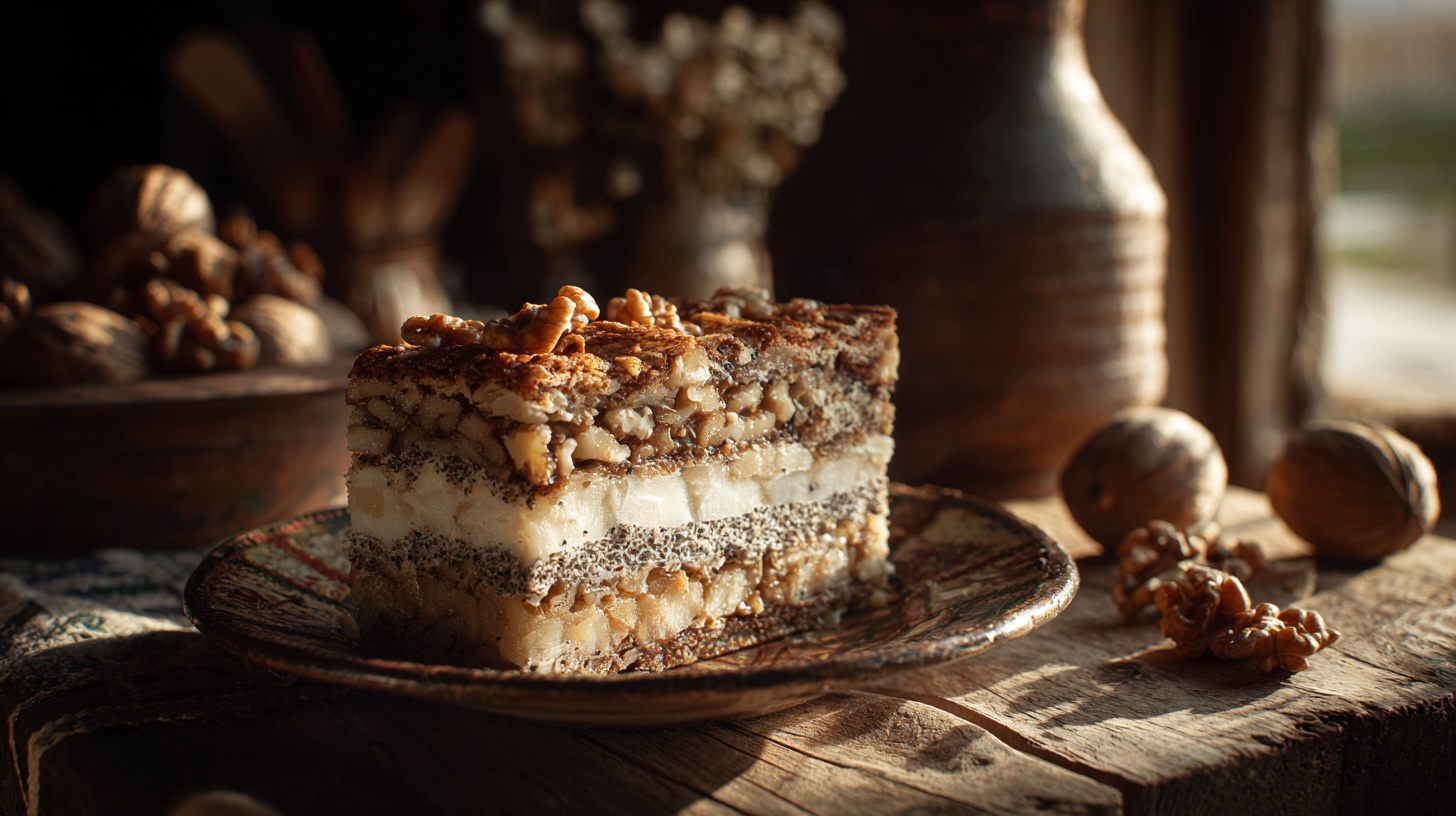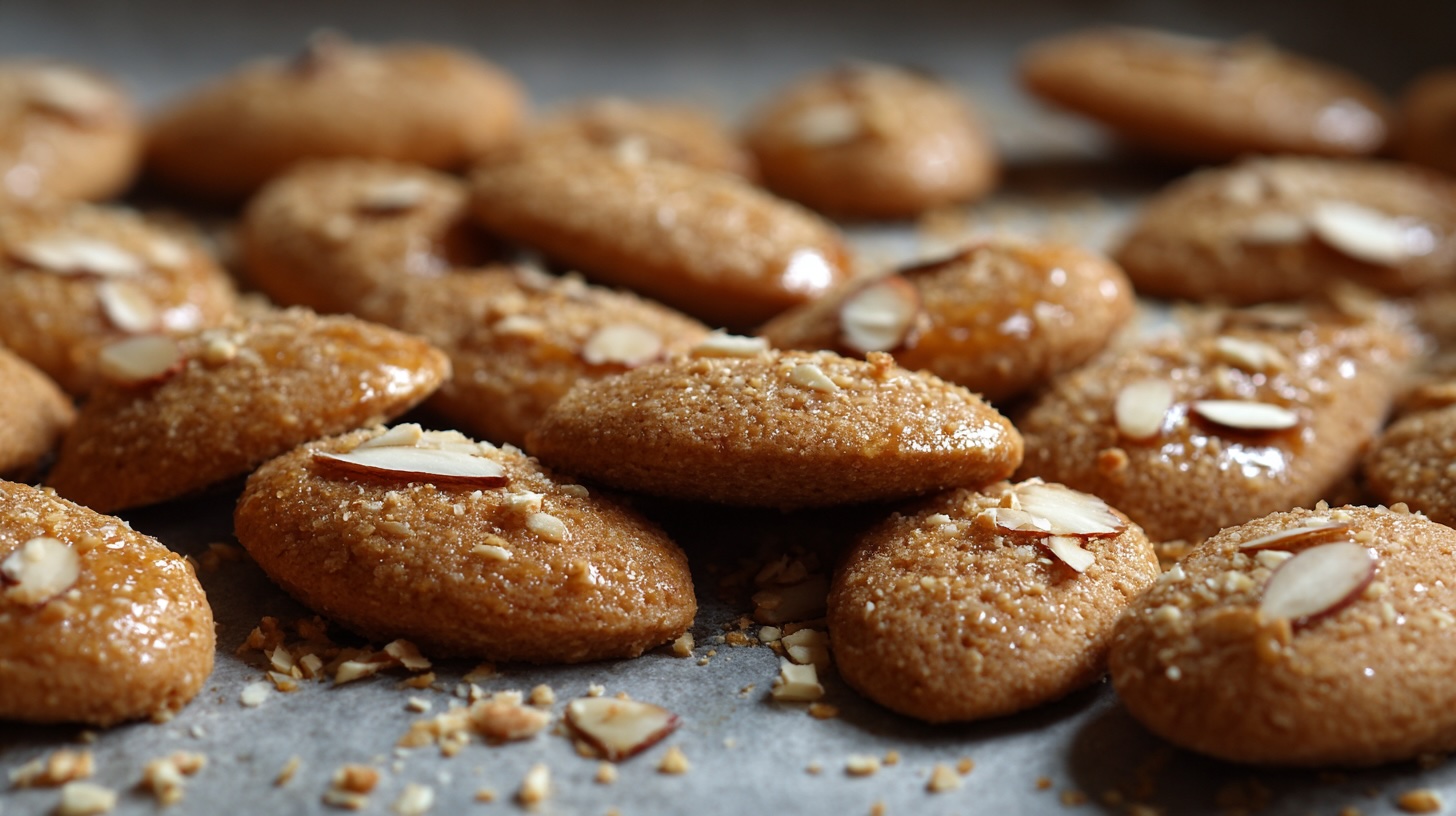Melktert: South African Milk Tart
Milk Tart or Melktert
Milk tart, known as melktert in Afrikaans, is a traditional South African dessert that has secured its place in the hearts of many. This sweet custard delight is renowned for its creamy filling and mildly sweet taste, making it a beloved treat across the country. The origins of milk tart can be traced back to the early colonial period, influenced by the Dutch settlers who brought recipes for custard-based desserts. Over time, it has evolved into a staple that not only embodies the culinary heritage of South Africa but also reflects its diverse cultural influences.
The cultural significance of melktert extends beyond its delicious flavor. It serves as a dessert typically enjoyed during family gatherings, celebrations, and festive occasions, often paired with warm memories of shared meals and communal experiences. The preparation of milk tart can also be seen as a way of preserving traditional practices, passed down through generations, thus reinforcing familial bonds and cultural identity.
At its core, milk tart consists of a soft custard filling, which is both smooth and comforting, nestled within a flaky pastry crust that adds a delightful texture contrast. This balancing act of flavors and textures is what makes the dessert so appealing to a wide audience. The simplicity of its ingredients—milk, sugar, flour, eggs, and a hint of cinnamon—speak to the rustic roots of South African cuisine. This humble yet captivating dessert has become versatile, inspiring variations and new interpretations while remaining a cherished classic. As we delve deeper into the history and recipe of this iconic dessert, it is clear that milk tart holds a special place in the culinary landscape of South Africa, inviting everyone to partake in its sweetness.
The History of Milk Tart
Milk tart, known as melktert in Afrikaans, has a rich history rooted in the traditions of the early Cape Dutch settlers who arrived in South Africa during the 17th century. This delectable custard dessert was originally inspired by the custards and tarts of European, particularly Dutch, cuisine. The integration of local ingredients and flavors illustrates the adaptability of the dish and its evolution into a uniquely South African dessert.
As the settlers established their farms, they began to incorporate the abundant resources of their new home into their recipes. The use of milk, developed from local dairy farming, became the central ingredient in melktert. The addition of eggs and sugar created a creamy custard texture, while a crumbly pastry crust provided a contrasting crunch. Over generations, families continued to refine their milk tart recipes, passing them down and making regional or personal modifications.
The evolution of the milk tart does not end with colonial influences; it also reflects the diverse cultural landscape of South Africa. Various communities, each with their own culinary customs, contributed to the preparation methods and flavor profiles of this classic dessert. For instance, some might add spices like cinnamon or nutmeg, while others experiment with citrus zest or a dollop of jam as a topping. These variations showcase how milk tart transcends its original form to embody the nation’s rich culinary heritage.
In contemporary South Africa, milk tart continues to be a beloved staple at family gatherings and celebrations. Its lasting popularity highlights the importance of food as a means of cultural expression and shared tradition. The ongoing evolution of melktert attests to its capacity to adapt while still serving as a nostalgic reminder of South Africa’s historical and culinary roots.
Key Ingredients of Milk Tart
The traditional South African milk tart, known as melktert, is renowned for its delicate custard filling and buttery crust. At the heart of this beloved dessert are several key ingredients, each contributing uniquely to its flavor and texture. The primary ingredient, of course, is milk, which serves as the base for the custard filling. Whole milk is most commonly used, providing a rich and creamy consistency that makes each bite indulgent. Its natural sweetness enhances the overall flavor profile of the tart.
Another essential ingredient is sugar, which adds the necessary sweetness to balance the milk’s richness. Typically, granulated sugar is utilized, but modern variations may incorporate alternative sweeteners such as agave syrup or honey to cater to different dietary preferences. Flour plays a crucial role in the crust of the milk tart, lending structure and stability. A simple shortcrust pastry made from all-purpose flour is traditionally used, but some recipes may explore gluten-free options for those with dietary restrictions.
Eggs are vital for achieving the desired custard texture, providing moisture and a smooth consistency. They help bind the filling together, ensuring it sets properly when baked. Lastly, cinnamon is often sprinkled on top of the milk tart, infusing it with a warm spice that complements the creamy filling beautifully. Some variations may also incorporate other spices such as nutmeg or cardamom, adding a unique twist to the traditional flavor.
In contemporary adaptations of melktert, creative cooks may experiment with various flavors and ingredients, such as adding vanilla extract or even citrus zest to brighten the taste profile. These innovations allow the classic milk tart to evolve while retaining its quintessential characteristics, ensuring that this cherished dessert continues to delight palates worldwide.
Step-by-Step Recipe for Melktert
To prepare a traditional South African milk tart, also known as melktert, one must start with the pastry crust, followed by the custard filling. Here is a comprehensive guide to making this delightful dessert from scratch.
For the crust: Begin by gathering the following ingredients: 1 ½ cups of all-purpose flour, ½ cup of unsalted butter (softened), ¼ cup of sugar, 1 egg yolk, and a pinch of salt. In a mixing bowl, cream the softened butter with sugar until light and fluffy. Add the egg yolk and beat until well combined. Gradually mix in the flour and salt until the dough forms. Once combined, wrap the dough in cling film and refrigerate for at least 30 minutes.
After chilling, preheat your oven to 180°C (350°F). Roll out the dough on a floured surface to fit your tart pan. Carefully place the rolled out pastry in the pan, ensuring it covers the bottom and the sides. Prick the base with a fork to prevent bubbling and blind bake for about 15 minutes or until lightly golden. Allow it to cool while preparing the filling.
For the custard filling: In a saucepan, combine 2 cups of milk, ½ cup of sugar, and 2 tablespoons of butter, heating over medium heat until warmed. In a separate bowl, whisk together 3 egg yolks, ¼ cup of cornflour, and ½ teaspoon of vanilla extract. Slowly pour the warm milk mixture into the egg mixture while continuously stirring to prevent curdling. Return this mixture to the saucepan and stir until it thickens, which usually takes about 5-7 minutes.
Once the custard has thickened, pour it into the cooled pastry crust. Allow it to cool completely before refrigerating for at least 2 hours. This ensures the milk tart sets properly. For a delightful touch, sprinkle a little cinnamon on top before serving.
Tips: Ensure the milk is not boiling when combining with the egg mixture, as this can lead to scrambled custard. Stirring continuously during this process helps achieve a smooth filling. Enjoy your homemade milk tart, a true symbol of South African culinary tradition.
Serving Suggestions and Pairings
Milk tart, or melktert, is a traditional South African dessert that can be enjoyed in various delightful ways. One of the classic serving methods involves dusting the top of the tart with a light sprinkle of cinnamon, which complements its creamy custard filling beautifully. Additionally, it is often served chilled, providing a refreshing end to a meal. This traditional approach preserves the origins of the dish while allowing the subtle flavors to shine.
In contemporary settings, many choose to elevate the milk tart experience by garnishing it with whipped cream or fresh fruits. A dollop of whipped cream adds a luxurious creaminess, while fruits such as berries or citrus slices can introduce a vibrant contrast of flavors and colors. These modern iterations appeal to a wide audience and can be especially appealing at gatherings or celebrations. Adjusting the presentation in this way not only enhances visual appeal but also adds complexity to the taste profile of the dish.
When it comes to selecting beverages that pair well with milk tart, both tea and coffee options stand out. A calming cup of rooibos tea or traditional South African chai complements the custard’s sweetness and adds warmth to the dining experience. For coffee enthusiasts, the rich flavors of an espresso or a smooth cappuccino provide a satisfying counterbalance to the dessert’s creaminess. Each beverage enhances the milk tart, enriching the overall enjoyment of this beloved treat.
In conclusion, whether one adheres to traditional serving customs or opts for innovative garnishing methods, milk tart remains a versatile dessert that can delight the palate. By thoughtfully considering beverage pairings as well, one can create a comprehensive dining experience that showcases this sweet custard delight in all its glory.
The Role of Milk Tart in South African Celebrations
Milk tart, known as melktert in Afrikaans, holds a cherished place in the hearts of many South Africans, particularly during celebrations and festive occasions. This classic dessert, characterized by its creamy custard filling and flaky crust, is often a centerpiece at family gatherings, holidays, and special events. The significance of milk tart goes beyond mere taste; it represents unity, tradition, and the joy of sharing culinary experiences with loved ones.
During major holidays such as Easter and Christmas, milk tart is frequently baked and shared among families and friends. It is not uncommon for the preparation of this dessert to become a family tradition, where recipes are passed down through generations, often with personal twists added by home bakers. Families come together to celebrate these occasions, exchanging laughter and stories, with milk tart being the sweet reward of their time spent together.
Furthermore, milk tart often graces tables at informal gatherings, birthday parties, and even milestone celebrations like weddings and anniversaries. Its creamy texture and evanescent sweetness appeal to a wide age range, making it an accommodating dessert choice that fosters a communal spirit. There are numerous anecdotes that highlight memorable moments associated with this delightful treat, such as a grandmother teaching her grandchildren the delicate art of baking melktert, imparting not only culinary skills but also lifelong bonds.
In South Africa’s diverse cultural landscape, the milk tart’s presence in various festivities signifies its universal appeal, transcending cultural boundaries. Regardless of the specific celebrations, the act of enjoying milk tart together encapsulates a sense of belonging and shared heritage that resonates deeply. Ultimately, this humble custard delight emerges not only as a dessert but as a symbol of love, connection, and joyous gatherings across all spectrums of South African society.
Variations of Milk Tart Across South Africa
Milk tart, or melktert, is a beloved dessert that showcases the rich culinary heritage of South Africa, and its variations can be found across different regions. Each community adds its own twist to this traditional custard pie, reflecting local tastes, available ingredients, and cultural influences. As a result, the classic milk tart recipe has evolved into diverse adaptations that delight both locals and visitors.
In the Western Cape, for instance, many bakers incorporate lightly spiced cinnamon and nutmeg into their milk tart fillings, which adds a warm flavor profile that resonates well with the region’s fondness for spices. The crust often features a touch of coconut, which introduces a subtle sweetness and tropical essence to the dish. In contrast, those in the Eastern Cape may opt for a more rustic approach, utilizing a simple pastry crust and enhancing the custard with the addition of a lemon or orange zest. This variation not only enhances the taste but also brings a bright freshness, characteristic of the coastal climate.
Meanwhile, in KwaZulu-Natal, the use of cardamom gives milk tart a distinctive aromatic quality that speaks to the Zulu heritage of the region. Additionally, the custard in this area might be prepared with local dairy that imparts a unique flavor, making their version truly special. In certain rural areas, traditional milk tart is also made with maize flour instead of wheat flour for the crust, showcasing the ingenious use of locally-sourced ingredients.
As one travels further north, one may also encounter milk tart recipes that incorporate regional fruits like guava or passionfruit, adding an exciting twist to the classic custard. Such variations of melktert not only celebrate the diverse ingredients found in South Africa but also highlight the cultural richness and community pride that surrounds this cherished dessert.
Healthier Twists on Melktert
The classic South African milk tart, or melktert, is cherished for its creamy, custard-like filling and flaky crust. However, as dietary preferences and health consciousness evolve, many individuals seek lighter adaptations of this beloved dessert. Healthier twists on milk tart can maintain its delightful essence while catering to those looking for alternatives that fit various dietary needs.
One popular adaptation is the sugar-free milk tart, which utilizes natural sweeteners such as stevia or erythritol. These substitutes provide a similar sweetness without the calories or glycemic impact of traditional sugar, making the dessert suitable for diabetics or those monitoring their sugar intake. Furthermore, these sweeteners often allow the rich, comforting flavor of the custard to shine through, retaining the integrity of the original recipe.
For those with gluten sensitivities or preferences for gluten-free diets, experimenting with alternative crust options can yield delicious results. Almond flour or ground oats can be combined to create a wholesome, gluten-free crust that supports the rich filling of the milk tart, ensuring that everyone can enjoy this traditional favorite. By incorporating healthier ingredients, the dessert not only caters to dietary restrictions but also adds nutritional value.
Dairy-free fillings have also gained popularity, especially among vegans and those with lactose intolerance. Utilizing plant-based milk, such as almond or coconut milk, and thickeners like cornstarch or aquafaba, can replicate the creamy texture and flavor profile of the traditional milk tart. By exploring these variations, dessert enthusiasts can relish the indulgence of melktert without compromising their dietary choices.
Overall, the world of healthier twists on milk tart is vast and inviting. Individuals are encouraged to experiment with these alternatives while appreciating the rich cultural history embedded within this timeless dessert.
The Timeless Appeal of Melktert
Milk tart, or melktert as it is affectionately known, holds a special place in the hearts and kitchens of South Africans. This beloved dessert not only represents the rich culinary heritage of the country but also evokes a sense of nostalgia and comfort among those who enjoy it. With its creamy custard filling and a touch of cinnamon, milk tart transcends mere dessert status, becoming a comforting reminder of family gatherings and cherished homemade treats.
The enduring appeal of milk tart can be attributed to its simplicity and versatility. Its base, usually made from easily accessible ingredients, allows for personal variations that can reflect individual tastes and preferences. From the traditional baked version to no-bake adaptations, milk tart continues to evolve while maintaining its quintessential characteristics. This adaptability ensures that it remains relevant in contemporary culinary practices, appealing to both seasoned cooks and novices alike.
Moreover, milk tart serves as a cultural bridge, connecting generations and bringing people together around the dining table. Families often pass down cherished recipes, with each generation adding its own flair, creating a collective culinary legacy that enriches the experience of making and sharing this delightful treat. The process of preparing melktert offers an opportunity for bonding, as young chefs learn the secrets of their ancestors while sharing stories and laughter in the kitchen.
As we reflect on the timeless allure of milk tart, we encourage readers to try making this classic dessert at home. Embrace the rich flavors and aromas that fill the kitchen as you craft your own version of this sweet custard delight. By doing so, you join a legacy that spans generations, celebrating a dish that is a true embodiment of South African culture.



